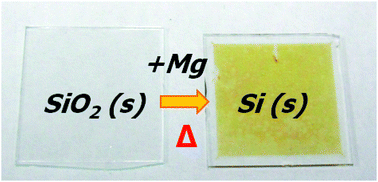Scientists from Taiwan have developed a cheap and green method for producing nanocrystalline silicon thin films.

In this work Kuei-Hsien Chen, Li-Choyong Chen and colleagues from National Taiwan University and Academia Sinica, Taipei, used a magnesiothermic reduction process to successfully convert the surface of soda lime glass into a silicon thin film. This involves using thermal evaporation to deposit a thin layer of magnesium onto the glass, followed by heating to produce the silicon. The film thickness can easily be controlled by varying the reaction time, and the band gaps of the resulting films were within the range of 2.3-2.5 eV.
This article is free to access until the 21st March 2012! Click on the link below to find out more…
Patterned growth of nanocrystalline silicon thin films through magnesiothermic reduction of soda lime glass, Deniz P. Wong, Hsiang-Ting Lien, Yit-Tsong Chen, Kuei-Hsien Chen and Li-Chyong Chen, Green Chem., 2012, DOI: 10.1039/C2GC16459K
Stay up-to-date with the latest content in Green Chemistry by registering for our free table of contents alerts.










